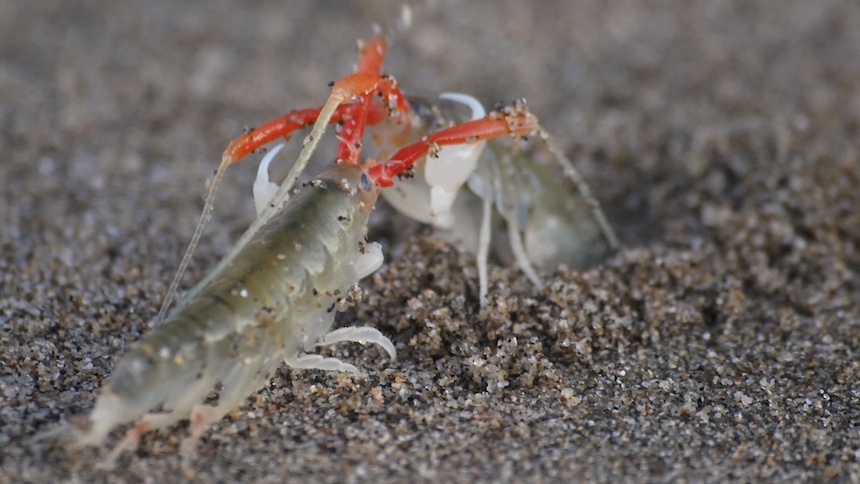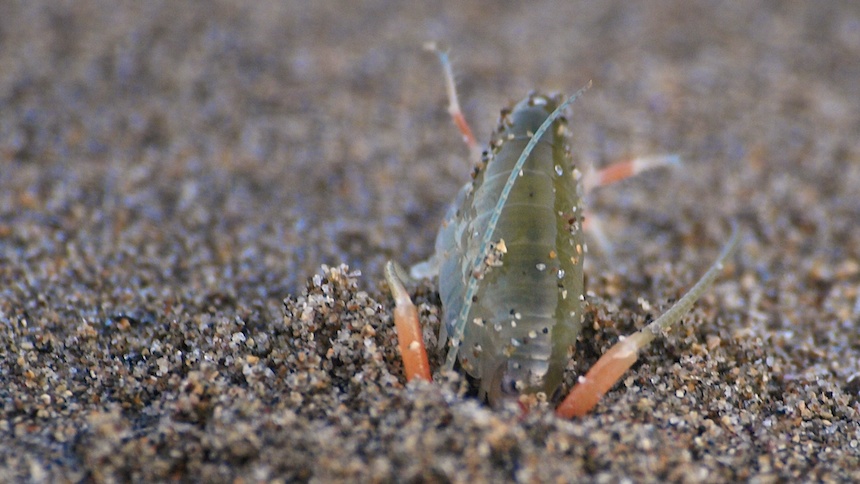
California Beach Hopper – ©ingridtaylar
Chris Anderson said it back in 2004: The Internet has a long tail . . . so long, in fact, that a person can leap from being a writer one day, to a budding amphipodologist the next. This may not be the anecdote Anderson had in mind when he wrote about the long tail. But, it is an example of an unusual photo, that found its way into a precise niche, because of the reach of the Internet. Some of the best opportunities arise out of unfulfilled expectations.
———————————-
Our expectation that morning was: super-low tide at Bowling Ball Beach in Mendocino County, captured with my wide angle in hues of sunrise magenta. Instead, we got a traffic snarl of abalone divers and a washed-out trail leading to lensperation (lens desperation). The sun was coming up, we were nowhere near getting the shots for which we’d forgone sleep. And, we were tangled in vines along an ungroomed section of unmarked trail to an unpopulated beach.
That’s when the unexpected camera magic happened: shifting sand. Not shifting in the Elvis sense (“let’s shift some sand”), but shifting in the amphipod sense. The sand-scape was alive with California Beach Hoppers foraging before burrowing time. I posted some photos of the scene in a previous post, and put a few pics on Flickr.

Fast forward a year plus change. I get a note about these photos — a request to use an image in an academic project. These usages, educational and nonprofit, are the main reason I license some photos under Creative Commons. This version of the long tail leads to unexpected and often interesting encounters . . . in this case, two folk meeting over a picture of an amphipod.
Here’s what I learned from the exchange, insight that adds dimension to my previous discovery on that Mendocino beach. About the dueling Beach Hoppers:
“It’s so funny to see the two males interacting . . . one following, and then diving down the other’s burrow. I’ve spent a large part of my research career studying Ligiids, most notably Ligia pallasii, but I’ve never seen any interactions like the ones you’ve documented with these amphipods.” 1
When I asked if this is behavior you’d commonly see in these amphipods, he said . . .
“Yes. They seem to have a lot of time on their ‘hands,’ and use it aggressively to raid the burrows of other males. Inside these burrows, if the invader is lucky, will be a harem of females being guarded by the previous occupant. The females only mate after moulting, they moult only once during their lifetimes, and they do it asynchronously. Consequently, a male with a harem must be vigilant for receptive females and be ready and on guard for other raiding males. A male’s prowess appears to be measured by the robust colour and length of his antennae, and it is apparently these attributes that convince a female to be corralled in a harem.” 1
This, to me, is the allure of participating in the Creative Commons and alternative copyright world. I’ll leave the controversy of copyright and commons to other public forums for now. My personal and anecdotal share-alike experience is marked by exchanges like those above which, for me, fuel a more creative and inspired online universe. And, from a purely selfish standpoint, I can enjoy being (in my correspondent’s words) “a budding amphipodologist” . . . for the day.
1Excerpted with permission.

Leave A Comment